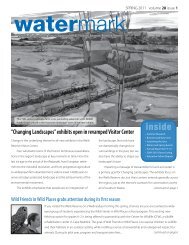Management Plan - National Estuarine Research Reserve System
Management Plan - National Estuarine Research Reserve System
Management Plan - National Estuarine Research Reserve System
You also want an ePaper? Increase the reach of your titles
YUMPU automatically turns print PDFs into web optimized ePapers that Google loves.
Appendix Fminor construction projects in sufficient detail to allow these projects to begin in the initial phaseof acquisition and development. A categorical exclusion, environmental assessment, or EIS maybe required prior to construction;7. (i) An acquisition plan identifying the ecologically key land and water areas of the <strong>Reserve</strong>,ranking these areas according to their relative importance, and including a strategy forestablishing adequate long-term state control over these areas sufficient to provide protectionfor <strong>Reserve</strong> resources to ensure a stable environment for research. This plan must include anidentification of ownership within the proposed <strong>Reserve</strong> boundaries, including land already inthe public domain; the method(s) of acquisition which the state proposes to use—acquisition(including less-than-fee simple options) to establish adequate long-term state control; an estimateof the fair market value of any property interest—which is proposed for acquisition; a scheduleestimating the time required to complete the process of establishing adequate state control of theproposed research reserve; and a discussion of any anticipated problems. In selecting a preferredmethod(s) for establishing adequate state control over areas within the proposed boundariesof the <strong>Reserve</strong>, the state shall perform the following steps for each parcel determined to bepart of the key land and water areas (control over which is necessary to protect the integrity ofthe <strong>Reserve</strong> for research purposes), and for those parcels required for research and interpretivesupport facilities or buffer purposes:(A) Determine, with appropriate justification, the minimum level of control(s) required [e.g.,management agreement, regulation, less-than-fee simple property interest (e.g., conservationeasement), fee simple property acquisition, or a combination of these approaches]. This does notpreclude the future necessity of increasing the level of state control;(B) Identify the level of existing state control(s);(C) Identify the level of additional state control(s), if any, necessar to meet the minimumrequirements identified in paragraph (a)(7)(i)(A) of this section;(D) Examine all reasonable alternatives for attaining the level of control identified in paragraph(a)(7)(i)(C) of this section, and perform a cost analysis of each; and(E) Rank, in order of cost, the methods (including acquisition) identified in paragraph(a)(7)(i)(D) of this section.(ii) An assessment of the relative cost-effectiveness of control alternatives shall include areasonable estimate of both short-term costs (e.g., acquisition of property interests, regulatoryprogram development including associated enforcement costs, negotiation, adjudication, etc.) andlong-term costs (e.g., monitoring, enforcement, adjudication, management and coordination). Inselecting a preferred method(s) for establishing adequate state control over each parcel examinedunder the process described above, the state shall give priority consideration to the least costlymethod(s) of attaining the minimum level of long-term control required. Generally, with thepossible exception of buffer areas required for support facilities, the level of control(s) requiredfor buffer areas will be considerably less than that required for key land and water areas. Thisacquisition plan, after receiving the approval of NOAA, shall serve as a guide for negotiationswith landowners. A final boundary for the reserve shall be delineated as a part of the finalmanagement plan;8. A resource protection plan detailing applicable authorities, including allowable uses, usesrequiring a permit and permit requirements, any restrictions on use of the research reserve, anda strategy for research reserve surveillance and enforcement of such use restrictions, includingappropriate government enforcement agencies;9. If applicable, a restoration plan describing those portions of the site that may require habitatmodification to restore natural conditions;10. If applicable, a resource manipulation plan, describing those portions of the <strong>Reserve</strong> buffer inwhich long-term pre-existing (prior to designation) manipulation for reasons not related toresearch or restoration is occurring. The plan shall explain in detail the nature of such activities,<strong>Management</strong> <strong>Plan</strong>: Appendix F201




